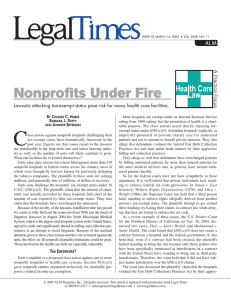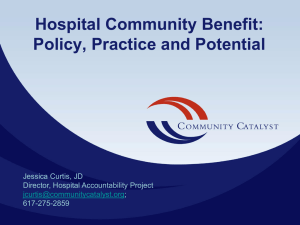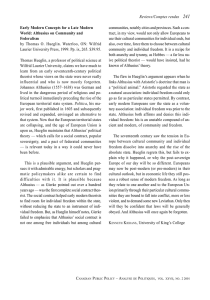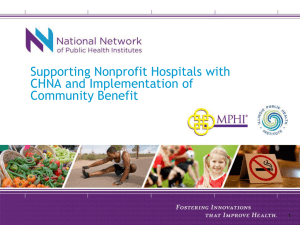Toward a Theory of Nonprofit Institutions: An Economic Model of a
advertisement
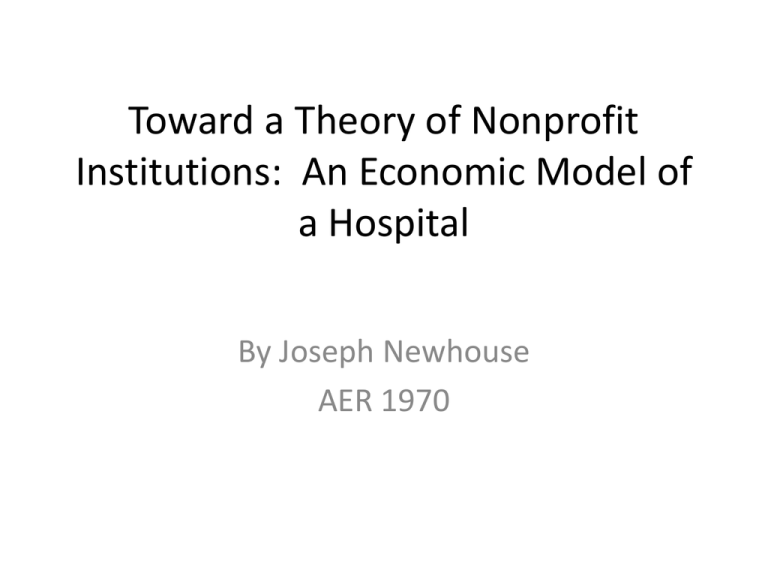
Toward a Theory of Nonprofit Institutions: An Economic Model of a Hospital By Joseph Newhouse AER 1970 • First real attempt to model non-profit institutions. – Until about 1970 nonprofits just a small portion of the economy, but became significant – In 1966, $15 billion was spent on hospital care • Context, 1966 US GDP was $780.8 • So was almost 2% of GDP. – Hospitals employed 1.3 million people in 1963, about twice as many as steel mills and motor vehicle producers. • Model makes some concessions from reality – Most important, that hospital expenses are financed by consumers, not insurance or other third parties. – Means that demand is more responsive to price than perhaps is with third party payers. – Also means the model is more general than hospitals, for example, applies to universities where (at the time) third party payment was rare. • Primary concern is relationship between nonprofit status and efficiency. • Postulate a maximand of quantity of services for the hospital administration. – Based on the idea that consumers have a “right” to medical care. – Basis for tax exemption and other legal privileges granted hospitals. – Ethos is that the public is better off if it consumes more hospital services (and apparently, less of some other services) • He discusses why the board, medical staff and other people involved will want quantity to be the maximand. • Implication of the goal of quantity maximization is that we must assume downward sloping demand (Why?) – Incentive is to keep price as low as possible – with possible price discrimination (why?) • But then brings in prestige which is also of concern to the hospital, and achieved from high quality. • Final model, maximizing some value, call it utility, with respect to quantity and quality. – Common goal in the hospital trade literature – Widely adopted in the economic analysis of hospitals and other nonprofit institutions • Cannot maximize quality and quantity without limit – Nonprofit faces a budget constraint; a limit on the allowable deficit. – Final objective is constrained quantity-quality maximization • Discussion of how quantity and quality are measured – Quantity is straightforward – Quality is a vector of characteristics, quantifiable or measured as a binary present or not. • Quantity demanded for each hospital is a function of quality and price Qd=f(q, P) where q=quality and P=price f1>0m f2<0. – Quality is costly, so ↑q will increase cost – Each quality vector has an associated cost • Newhouse assumes, under the previous assumption, that a higher cost indicates a higher quality. – Averts the problem of measuring quality directly – Is this a good assumption? • Hence average cost, AC, depends on the level of quality – Higher quality shifts up the AC • Assume no deficit, implying that P=AC (why?) – For any given quality, choose the AR to max Qd For quality q0, which gives AC curve AC0, the first sets quantity at q0. Both the AC and the demand curve shift as quality increases. As a result, the new equilibrium may lie to the left or right of q0. The result is a locus of equilibrium points indicating a quantity-quality tradeoff which will eventually bend backward (Why must it bend backward, and what does this indicate about the relative elasticities of Qd and AC with respect to quality?) The hospital chooses the point on this tradeoff which yields the highest utility. • Extensions to the basic model – Allowable deficit (say because of charitable giving) • Shifts the tradeoff curve to the right at each quality level • Enables a higher indifference curve (higher utility) to be achieved • Explains fund raising efforts – Fund raising carried on until the marginal benefit, in terms of additional utility, equals the marginal cost of the fund raising – Model implies least-cost production (technical efficiency, MRP=MFC) • Get least cost production for the given output – Not globally least cost production – And, for any given quality, a greater output than a profit maximizer with market power (despite what Newhouse says) AC AR MC MR q qN Other differences • For profit will produce a wider variety of quality, i.e., would produce all quality levels that are profitable. • Not for profit has a bias towards quality (from the objective function) hence will not produce some quality even if profitable. – Lower quality allows greater quantity, but lowers maximand. – Bias towards “Cadillac only” care – Predicts duplication and redundancy of equipment and services • Has become a big issue in the literature: Do for profit hospitals produce lower quality care? – Back in 1965 evidence was yes, based on accreditation, staffing, etc. – More recent evidence much more ambiguous Social outcome • Duplication of equipment and services – Quality goal and prestige of high intensity services – Possible lower cost and fund raising incentives • Choice on quality-quantity tradeoff is management optimizing not socially optimizing – Biased by philanthropy (evidence, Rosenman and Li, HCMS, 2002, showed grants increased quality, donations increased quantity at notfor-profit clinics in California) • Nonprofit status works as a barrier to entry, since no clear motivation for entry – Only potential write-off for donors, but no incentive for new facilities – Growth of for-profit hospitals has likely improved efficiency in the hospital sector – Actual and potential for-profit entry forces not-for-profit to be more efficient • Insurance lowers the price incentive • So not socially optimal. Why? – Decision makers choose the quality-quantity tradeoff that is best for them, not the social optimum. – Philanthropy biases the outcome. • Rosenman and Li “Buying Healthcare Quality with Grants and Donations,” Health Care Management Science, 5(2002): 25-32 showed nonprofit clinics use giving to support quantity, but government grants are used to expand quality – Barriers to entry remove market discipline • No room for entrepreneurs to exploit profit potential • Changed in recent years – Third party payers removes price discipline even more • Managed care has changed this a bunch.





